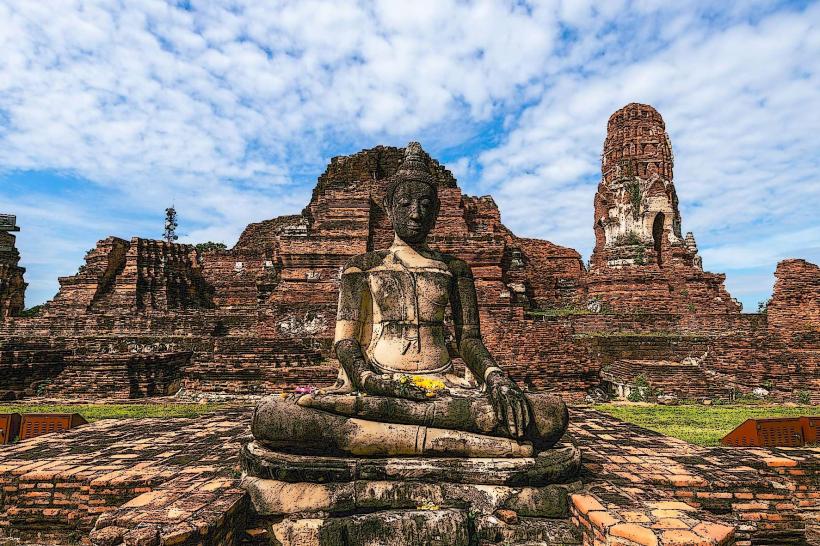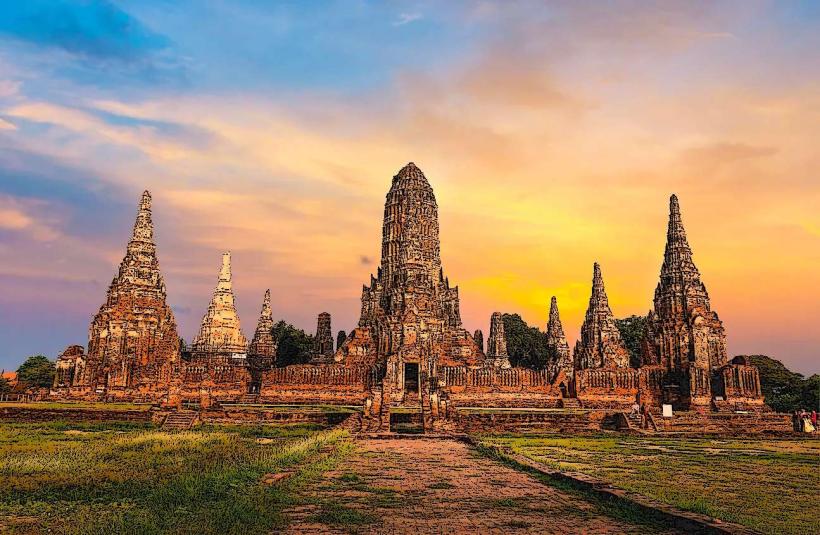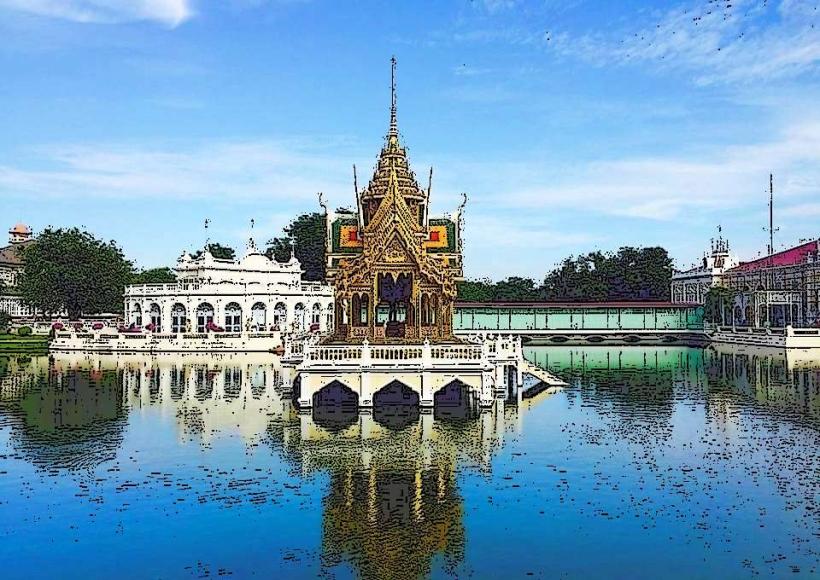Information
Landmark: Ayutthaya Historical ParkCity: Ayutthaya
Country: Thailand
Continent: Asia
Ayutthaya Historical Park, Ayutthaya, Thailand, Asia
Overview
In the heart of Ayutthaya, Thailand, the Ayutthaya Historical Park-a UNESCO World Heritage Site-holds crumbling temple spires and weathered stone paths, and it’s one of the country’s most treasured historical and cultural landmarks, where visitors can wander among the weathered brick ruins of Ayutthaya, the ancient capital that thrived from 1350 to 1767.Funny enough, In 1350, King U-Thong founded Ayutthaya, a riverside city that soon rose to become the capital of one of Southeast Asia’s most powerful and prosperous kingdoms, along with perched where the Chao Phraya, Lopburi, and Pa Sak rivers meet, it thrived as a bustling hub of trade, culture, and politics, with boats crowding the water like a floating marketplace.In 1767, after over four hundred years of splendor, the Burmese army stormed Ayutthaya, burning its golden temples and leveling the city, furthermore looters swept through the city, setting temples ablaze, and by morning, most buildings stood as blackened shells.Though so much lies in ruins, many vintage monuments still stand, offering a glimpse of the ancient capital’s grandeur-weathered stone arches and all, what’s more ayutthaya Historical Park stretches across a wide expanse, where crumbling temple spires, weathered palaces, and ancient stone monuments rise from the grass.Visitors can wander among these remnants, tracing the kingdom’s rich cultural and architectural heritage in worn carvings and sun‑warmed stone, in addition in Ayutthaya Historical Park, Wat Mahathat draws countless visitors with its towering central prang and the unforgettable sight of a Buddha’s head cradled in the twisted roots of an ancient tree.Once, the temple thrived as a royal and spiritual hub, its halls guarding sacred Buddha relics wrapped in faded silk, also with its striking design and the Buddha head half-hidden in tree roots, it’s a sight you can’t miss.Wat Phra Si Sanphet, the grandest and most revered temple of the Ayutthaya Kingdom, rose within the royal palace grounds, its spires gleaming in the sun, simultaneously the temple draws visitors to its three towering chedis, each beautifully restored and holding the remains of former kings.It became the inspiration for Bangkok’s Wat Phra Kaew, the Temple of the Emerald Buddha, where sunlight flashes off the golden roof, equally important built in 1424 by King Borommarachathirat II, Wat Ratchaburana is known for its towering prang and vivid interior murals, where faded gold still glints in the light.They built the temple on the very ground where King Intharacha’s two sons fell in battle, swords clashing over the throne, meanwhile step inside the prang and you’ll discover an ancient crypt, its cool air heavy with the scent of timeworn stone, holding relics and artifacts from centuries past.As it happens, Wat Phra Ram sits close to the royal palace, its tall prang rising above a cluster of weathered chedis, likewise king Ramesuan built it to honor his father, King U-Thong, and today its crumbling stone doorways still hint at the sweeping elegance of Ayutthaya architecture.In 1630, King Prasat Thong built Wat Chaiwatthanaram, one of Ayutthaya’s most striking temples, its towers rising like stone flames in a design inspired by Cambodia’s Angkor Wat, after that the tall central prang rises above a ring of smaller chedis, their weathered stone catching the afternoon light in a breathtaking display.The temple sits on the banks of the Chao Phraya River, where long-tail boats glide past and the water catches the sunlight, what’s more wat Yai Chai Mongkhon, with its towering chedi rising like a golden spear against the sky, was built by King U-Thong and later restored by King Naresuan.The temple’s known for its massive reclining Buddha, gleaming gold in the light, and for the neat rows of seated Buddhas that circle the grounds, after that the Ayutthaya Historical Study Center sits just steps from the weathered ruins of Wat Phra Si Sanphet and gives visitors a deep dive into the rich history of the Ayutthaya Kingdom.The museum showcases the kingdom’s culture, economy, politics, and art, alongside artifacts from its ancient city-like worn coins that still bear the king’s profile, as a result the Elephant Kraal was the royal camp where Ayutthaya’s kings tamed and trained their elephants, the air heavy with the scent of dust and grass.Interestingly, At the site, a wide circular structure sits behind a weathered wooden fence, and visitors discover how elephants once marched at the heart of the kingdom’s military and shaped its cultural traditions, what’s more about 20 kilometers south of Ayutthaya, the Bang Pa-In Summer Palace once served as a peaceful retreat for Thai kings, its white pavilions reflected in the still waters of the surrounding ponds.The palace complex blends European grace, Chinese elegance, and Thai charm, with a gilded roof catching the afternoon sun, also chao Sam Phraya National Museum, just a short meander from Wat Ratchaburana, holds a rich trove of Ayutthaya treasures-gleaming golden Buddha statues, intricate jewelry, and centuries‑heritage pottery still dusted with history, roughly Ayutthaya Historical Park stretches wide, with crumbling stone temples scattered under the sun, and the best way to spot it all is to wander on foot or pedal through on a bike, at the same time many tourists hop on rented bikes, pedaling past mango trees as they make their way from one temple to the next.You can rent a bike just inside the park’s entrance, where the air smells faintly of pine, while boat Tours: Cruise the Chao Phraya River and watch Ayutthaya’s ancient temples slide past, offering a fresh view of the city you can’t get from the streets.You can hop on one of several boat tours to spot the temples and the lush riverside scenery, with a stop at Wat Chaiwatthanaram where golden spires catch the late-afternoon light, in addition photography lovers will find Ayutthaya Historical Park a dream-crumbling brick temples, weathered stone Buddhas, and a halo of green trees that rustle in the warm breeze.Just before the sun slips below the horizon, the golden hour bathes the temples in a soft, honeyed glow that’s perfect for capturing their beauty, not only that ayutthaya Historical Park welcomes visitors every day from 8:00 in the morning until 6:00 in the evening, when the sun slips low over the ancient ruins.You’ll need to pay to enter Ayutthaya Historical Park, and each temple-like the one with the giant seated Buddha-has its own separate fee, meanwhile at some temples, you can buy one ticket that covers everything, but at others, you’ll need separate tickets for each hall you visit, sort of The ideal time to notice Ayutthaya is between November and February, when cooler air drifts through the streets and wandering among the temple ruins feels easy and pleasant, alternatively the park stays open all year, so you can drop by anytime-even on a crisp winter morning, in a sense It appears, Driving to Ayutthaya is easy-it’s about 80 kilometers north of Bangkok, roughly an hour to an hour and a half on the road, at the same time just head up the Phahonyothin Road or take Highway 32, passing rows of rice fields along the way.You can hop on a train to Ayutthaya from Bangkok’s Hua Lamphong Station, where regular departures rattle north and reach the city in about an hour and a half to two hours, furthermore by bus, you can catch frequent departures to Ayutthaya from Bangkok’s Northern Bus Terminal (Mo Chit), and the ride takes about an hour and a half to two hours, enough time to watch the city fade into green rice fields.In conclusion, Ayutthaya Historical Park is a remarkable area where you can step among weathered stone temples and catch a vivid glimpse of Thailand’s deep cultural and historical roots, and ancient temples rise beside crumbling stone walls, framed by hills that glow in the late afternoon sun, making this a setting history lovers, architecture buffs, and photographers shouldn’t miss.Visiting Ayutthaya feels like stepping into the kingdom’s golden age, where crumbling brick temples glow warm in the late-afternoon sun.
Author: Tourist Landmarks
Date: 2025-09-15





